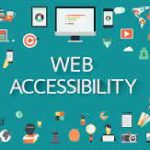According to Digital Commerce 360 analysis of U.S. Department of Commerce data 21.3% of online total sales was online in 2020. Online sales is expected to rise to 95% of total sales by 2040 (Nasdaq). 10% of those customers are people with some form of disability! Enabling accessibility of your digital assets will help your business capitalize on this market!
Through accessibility, your business can increase revenue both in the regular and disabled marketplace.
This blog post will explore how few institutions increased their revenues and gained up to 300% in sales by integrating accessibility components into their business offerings.
The University of Wisconsin stands as a beam for the rest of the institutions when implementing accessibility practices. UW – Madison prioritizes accessibility, not merely for legal compliance’s sake but for the potential impact they may have on disabled students. Disabled students have an exclusive ADA coordinator and an office for compliance to provide disabled student learning needs. ‘Make it accessible,’ educational policy of UW-Madison makes all website resources, educational content, administrative systems, and library resources fully accessible for disabled students. While ‘McBurney Disability Resource Center’ helps disabled students with digital and physical campus accommodations, the ‘Employee Disability Resources Office helps graduated students with campus placements after graduate studies. A $16.7 million grant for a vocational rehabilitation program to help disabled graduates find employment shows UW-Madison’s commitment to supporting students with disabilities, even after their student years. The initiatives and commitment to providing accessible education make the university highly popular among the disabled student population.
Approximately 1000 students with visual, hearing, physical, and psychological disabilities have been enrolled with the institution’s on-campus programs. The prospects for disabled student enrollments for UW accessible online courses have also been steadily increasing in recent years.
codemantra has worked with some of the leading universities like the University of Illinois and the University of Westminster to make their curriculum accessible to print-disabled students by conforming to AA standards of WCAG 2.1 guidelines (that is the basis for Section 508 & ADA). Read more about codemantra’s solutions for K-12, school districts & universities here.
Across the globe, children with disabilities have lower literacy rates than their regular fully-able students. It is a moral imperative to remove barriers to education for these disabled children. Accessible education can benefit approximately 93 and 150 million children in developing nations and over 7 million children in the United States. It can increase annual student enrollments, improve academic revenues, attract sponsors willing to fund on disability scholarships, and, more importantly, promote inclusive learning for students.
Tesco was the first retailer to launch an online marketplace to sell groceries and other consumer merchandise in 2000. As a practice that was way ahead of its time, 20 visually-impaired users performed alpha-testing on teso.com/access to test the accessibility features of the company’s disabled-friendly website. By 2001, 70 visually impaired and partially-sighted users beta-tested the website to improve the web accessibility of tesco.com. The retailer provided a uniform digital experience both for regular and physically disabled users through their inclusive digital offerings. Customers across the distributed global markets were able to buy over 30 items within 15 minutes with an average internet connection speed of 56K.
Tesco’s goal to optimize accessibility, both for desktop web and mobile browsers, translated as a 350% increase in sales. The sales which stood at GBP 52 million in 2000, grew to £235 million in 2001 – just a year after its launch. Today, Tesco no longer has a separate website for disabled customers. All aspects, tesco.com/access is now mainstreamed onto the main webpage tesco.com. This accessibility improvement has helped the retailer optimize their pages for the web, increase more mobile/web traffic, and soar their digital earnings.
As of 2021, Tesco still outranks many other retailers in ranking on the web for e-commerce. In the United Kingdom, online sales have rocketed to GBP 6.3 billion. Accessibility-driven marketplace offerings have helped Tesco gain this competitive advantage!
The COVID pandemic lockdown has forced many museums across North America, Europe, and Canada to adapt towards offering digital tours for museum-goers. ‘Virtual Museum Tours,’ ‘Members only digital events,’ ‘lecture series with curators,’ ‘Virtual science camps,’ are gearing to dominate as operational trends across the 75,000 museums in the United States.
codemantra provides digital asset management, content transformation, digital accessibility compliance, digital rights management (DRM), and distribution solutions to museums & art galleries. codemantra has assisted some of the leading museums like the Yale University Art Gallery and Yale Center for British Art in their digital transformation. Read more about codemantra’s solutions for museums & art galleries here.
Mattatuck Museum’s Quarantine edition of the popular Murder Mystery event was virtual in 2020: attracting visitors from across twenty-four states of the United States. USD 10 to USD 15 was charged(based on their membership status) to view the virtual tour. San Francisco’s ‘The Exploratorium’ museum offered similar virtual offerings during the pandemic lockdown: exclusive digital art content for paid members and attractive discounts on their online store collectives. The accessibility improvement to this online virtual offering made the ‘Denver Museum of Nature and Science’ offer virtual science academy programs at $140 per program.
After the COVID-19 pandemic lockdown, world museums are accelerating even more towards offering artworks and cultural content over the web. Enabling accessibility features for virtual museum initiatives would mean being inclusive and also leveraging newer monetization opportunities.
Barclay’s accessibility initiatives are class-apart! Assitance by sign language for the deaf & partially deaf to an online banking executive who communicates in sign language. Additionally, talking ATMs for the visually impaired, beacon technology to alert requests for special services during in-person banking, and high visibility personalized debit cards for the partially sighted are some of the benefits for disabled customers.
Reputed to be the most inclusive and accessible The Financial Times Stock Exchange (FTSE) 100 Indexed company, Barclay’s is taking advantage of the commercial opportunities while still complying with legal standards.
The positive stakes of disabled-friendly banks are high. Over 60 million disabled people in the United States have an average of $872 billion of total income. People with disabilities, including senior citizens and pensioners, have the purchasing power to acquire banking products – but they don’t, for the lack of assistance provided by many banks. Investing in accessibility will help financial institutions to reverse that!
People with disabilities stay committed to a bank that offers disabled-friendly services to them. They are also more likely to champion the bank and promote the banks’ accessible experiences among others in their social circles. Banking accessibility will improve a bank’s commercial viability, expand a loyal customer base, and enhance the bank’s brand reputation. Integrating accessibility features to digital assets is more a need than a value-add for banks and financial institutions today.
codemantra provides digital transformation & accessibility solutions that can be deployed alongside your existing applications. Read more about codemantra’s solutions for credit unions, commercial & development banks here.
Approximately 15% of the global population has some form of disability – to be precise, close to 2.3 billion people are fully or partially disabled. Together they have approximately $8 trillion of spending power. Providing digital accessibility would mean customizing business solutions to profit from this untapped trillion-dollar market!
Business can increase over 50% to 300% in sales, provided you are inclusive of the diverse customer communities. Accessible content is also organically searched engine optimized (SEO) content – It increases the possibility of your business ranked better on the web. Your business will gain better online visibility and improved web traffic, translating as increased leads for online sales.
Making digital assets accessible will help businesses gain traction both among disabled communities and on the web. At codemantra, we are in the business of making enterprises succeed using our accessibility solutions. Please email us at info@codemantra.com to learn more.






